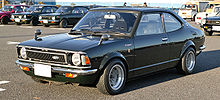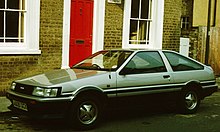Toyota Corolla Levin and Sprinter Trueno
This article needs additional citations for verification. (January 2021) |
| Toyota Corolla Levin/ Sprinter Trueno | |
|---|---|
 1983 Toyota Corolla Levin (AE86) | |
| Overview | |
| Manufacturer | Toyota |
| Also called | Toyota Sprinter Trueno |
| Production | March 1972 – August 2000 |
| Body and chassis | |
| Class |
|
| Body style | |
| Layout |
|
The Toyota Corolla Levin (Japanese:トヨタ・カローラレビン, Toyota Karōra Rebin) and the Sprinter Trueno (Japanese:トヨタ・スプリンタートレノ, Toyota Supurintā Toreno) are small, almost identical, lightweight, compact sports coupés which were produced by Toyota from 1972 to 2000. The name of this Corolla model was taken from one of the New Zealand venues of the Tasman Series motor races. However Levin in Old English does mean lightning and Trueno in Spanish means thunder. In Japan, the Corolla Levin was exclusive to Toyota Corolla Store locations, and the Sprinter Trueno was exclusive to Toyota Auto Store locations, later renamed Toyota Vista Store in 1980.
TE27 Series (1972–1974)[]


The first Corolla Levin and Sprinter Trueno of early 1972 were the high performance models of Corolla and Sprinter 2 door fastback coupe. They were powered by the 1.6 liter engines mated to a 5 speed manual transmission, borrowed from the Toyota Celica 1600GT. The inspiration came from Toyota manager Geisuke Kubo who wanted to offer something similar to the Alfa Romeo Giula Junior.[1] The Sprinter Trueno J had the 2T-B OHV with twin down draft carburettors. The other Levins and Truenos used the 2T-G (high compression) or 2T-GR (low compression) DOHC engines with two double venturi side draft Mikuni carburettors. Vehicles installed with the 1.6 litre engine obligated Japanese owners to pay more annual road tax.
TE37, TE47, TE51, TE55, TE61, TE62 & TE65 Series (1974–1979)[]



With the second generation of the Levin and Trueno Sprinter there was a clearer difference between the two through design. Though based on the same shell the whole nose design differed totally with the Levin (TE51 and TE55) having an aggressive forward raked design while the Trueno Sprinter (TE47, TE61, TE62 and TE65) had a sleeker and more curved design. In contrast to its predecessor this second generation of Levin and Trueno Sprinter was offered with a much wider array of engines and trim. The Trueno LT grade used the plain 2T engine and the Trueno ST grade used the twin downdraft carburettors 2T-B engine. The Levin and Trueno GT grades used the 2T-G engine with DOHC head from the previous TE27 with 86 kW (115 hp) from two double Mikuni Solex carburettors and later with 82 kW (110 hp) from the 2T-GEU engine with a Bosch K-Jetronic EFI system.
AE71/TE71/TE72/TE75 Series (1979–1983)[]

Although the sporty Corolla and Sprinter available as 2 door Sedan, 2 door Hardtop, 3 door Coupe, and 3 door Liftback, the Corolla Levin and Sprinter Trueno were only produced as 3 door Coupe (TE71). Trim levels for the Japanese models were Base, S, and GT APEX, all with 2T-G engine. In the United States, the Corolla Levin was sold as SR5 with 1.6 liter 4A-C engine (AE71) and 1.8 liter 3T engine (TE72/75).
AE85/86 Series (1983–1987)[]



In this generation, the Corolla Levin came with fixed rectangular headlights which distinguished it from the Sprinter Trueno with retractable headlights. However, the American Corolla SR5 and GT-S also had retractable headlights the same as Japanese Trueno, but with longer bumpers to meet the US Federal standards.
Engine
- 4A-GEU (16 valve): AE86 GT, GT APEX, GT-V Models
- 4A-GEC (16 valve): AE86 Corolla GT-S Model
- 4A-C (8 valve): AE86 SR5 Model
- 3A-U: AE85 SR, GT Models
AE91/92 Series (1987–1991)[]

When the AE92 Corolla was introduced in 1987, gone were the previous models' FR (front engined, rear wheel drive) layout and in its replacement was a more conventional FF (front engined, front wheel drive) system instead. Also gone were the previous generations' 3-door hatchback body style, now only offered with either a 2-door coupe, 4-door sedan, 3-door hatchback, or a 5-door liftback body, each with different designations respectively.
Similar to the AE86 generation, two different front end styles was offered. The "Trueno" model had a much more slanted front fascia with retractable pop-up headlights, the "Levin" model on the other hand, had a much more level hood line, and lacked he pop-ups in replacement of fixed rectangular headlights. Also unique with the coupe was the "GT-Z" trim, which was the highest and fastest trim model for the AE92 at the time. The trim comes equipped with Toyota's supercharged rendition of their 4A-GE engine, the 4A-GZE, now capable of producing 165PS (163HP) at 6400 RPM and 21.4 kg⋅m (210 Newton-meter) of torque at 4400RPM in its final iterations. All cars came with either a 5-speed manual or a 4-speed automatic, and as a factory option, a digital cluster was offered, similar to the one found in the AE86.
There were two major changes that happened to the car during its lifespan from 1987 to 1992. The early models, known as the Zenki (前期) in Japan, had a much less powerful engine, with the NA version making only 120PS and 14.5 kg⋅m of torque and the supercharged 4A-GZE making 145PS and 19.0 kg⋅m only. Other distinct features on the Zenki included different front bumpers for the "Levin" front end, having a different design with a small upper grille that extends to both ends of the bumper. In 1989, the model received a minor facelift and changes in engine performance, this later became known as the Kouki (後期) generation. Major rework was done to the 4A-GE, now adopting smaller intake ports compared to the previous design, hence its nickname: "Smallport". Along with a couple of upgrades mainly to the engine internals, the new engine made 20PS and 0.5kg⋅m more than its previous iteration (145PS, 15 kg⋅m) in naturally aspirated form, while its supercharged twin produced 165PS and 21.4 kg⋅m as a result of the change. The minor tweaks also upped the compression ratio from 9.4 to 10.3 (natural aspiration) and from 8.0 to 8.9 (supercharged). The front bumper now had a shorter upper grille that did not extend to both ends, with two side markers on each corner.
For the US market, the AE92 coupe only came with the "Trueno" front end, albeit with minor changes such as a different bumper design to satisfy US regulations. No US market AE92 GT-S came with the Japanese market's 4A-GZE engine, and hence it only came with the original naturally aspirated "smallport" version of the 4A-GE, producing 92 kW (123 hp; 125 PS) at 7200 RPM and 15.2 kg⋅m (149 N⋅m) of torque at 4800 RPM, 15 PS less than the Japanese market "smallport" 4A-GE. Other notable differences include the use of a MAF sensor on US market engines compared to a MAP sensor on Japanese market engines.
AE100/101 Series (1991–1995)[]


Along side the E100 Corolla, the Levin and Trueno underwent a full model change in June 1991. Japanese F1 driver Ukyo Katayama was appointed as the image representative for marketing as he was popular in Japan at the time and a commercial was broadcast in which Katayama runs a Levin on the Mine circuit with a catch phrase of "Ukyo, Levins".
As a model that was developed at the peak of the bubble era, the latest body, chassis, engine , transmission and safety technology was put into the E100 series. Consequently, the body size increased to the maximum width of the Japanese ‘regular 5 number ‘ and became heavier, which made it less attractive as a compact sports model than previous generations.
Continuing in the same tradition of offering 2 styles and names sold in different brand dealers in Japan , ‘Levin’ and ‘Trueno’ the E100 coupes were not exported officially to markets outside Japan, making it exclusively JDM. By the early 90s the 80s styling trend of using pop-up headlights was starting to make way for rounder more aerodynamic and luxury styling. The chassis was all new with higher rigidity body that was actually carried over to the next generation E110. Sharing the same wheelbase as the Corolla sedan, suspension was a re-tuned front and rear MacPherson strut. However, the biggest improvement was in the high performance 4A-GE engine. Any parts were redesigned and was equipped with VVT (the predecessor of VVT-i with a discontinuous variable valve timing mechanism) on the intake side camshaft, and used 5 valves per cylinder for a total of 20 valves. This was seen as revolutionary at that time as Yamaha motors who typically collaborated to engineer Toyota sport engines were actively using five valves per cylinder in their racing motorcycles. In addition, it was rare in a commercial vehicle of this class to be quipped with individual throttle body in order to increase engine response. Maximum power 160PS (157bhp) / 7,400rpm. However, the 4A-GZE type (170PS / 6,400rpm) with a supercharger has 16 valves as before, with many changes to the engine internals. The grade equivalent to the predecessor ZS was set as SJ. The engine was a 4A-FE type.
Super strut suspension, A revolutionary Toyota technology was standard for GT APEX (optional) and GT-Z (standard equipment). The GT-Z was equipped with a Viscous LSD as standard equipment. The GT APEX, which is not equipped with a super strut suspension, has an electronically controlled suspension TEMS (upper and lower G-sensitive type) as an option.
The 5A-FE type installed in the low-priced grade S reaches 105ps / 6,000rpm.
AE110/111 series (1995–2000)[]



Pre Facelift
- Manufactured from 1995 to 1997
Facelift Model
- Manufactured from 1997 to 2000
Engine
- 4A-GE (20v )"Black-Top": BZ-V, BZ-G, BZ-R Models
- 4A-FE: XZ Model
- 5A-FE: FZ Model
The BZ-R variant featured a 6 speed manual transmission, LSD, bigger front rotors, ABS, improved calipers, a taller rear spoiler and Super Strut Suspension (SS) all of which could be added to the BZ-G and BZ-V models as factory options. Additionally a set of Recaro SR3 (confetti pattern) seats could be installed as a factory option. This is the last series where the Trueno name was used, as the Toyota Sprinter was discontinued, the Corolla Levin continued to be made.
Other uses of "Levin" name[]
The name "Corolla Levin" was later revived for the Toyota Auris in Australia and New Zealand, where certain Corolla trim levels have the Levin label.
In China, the sporty model of the Toyota Corolla (E180) and Corolla (E210) with different lamps and bumpers from the regular sedan is called Levin (Chinese: 雷凌/凌尚; pinyin: Léilíng/Língshàng).
See also[]
References[]
- Toyota Corolla
- Toyota vehicles